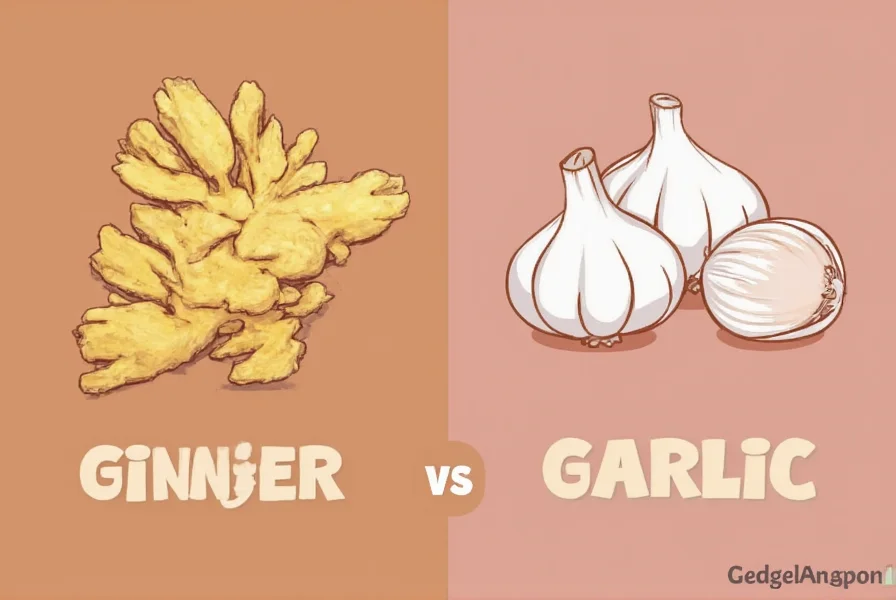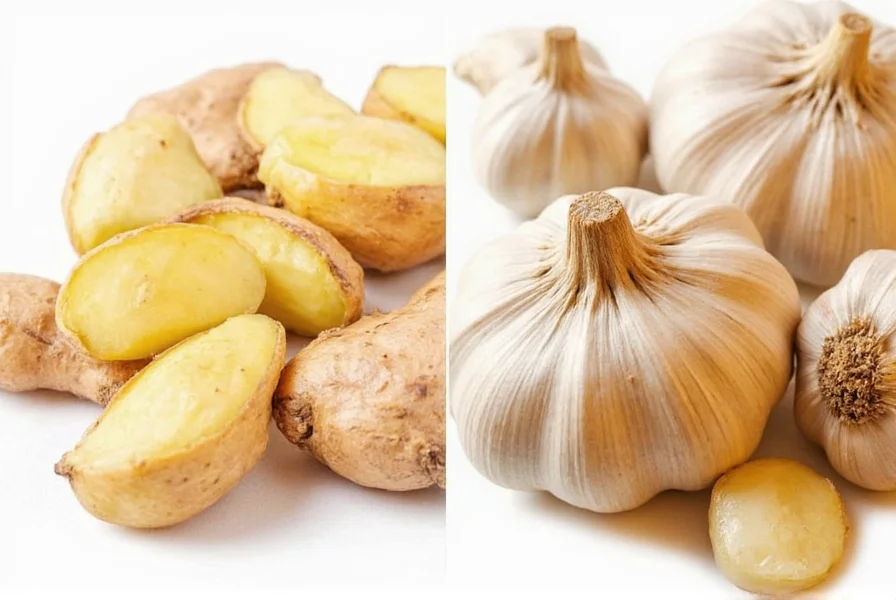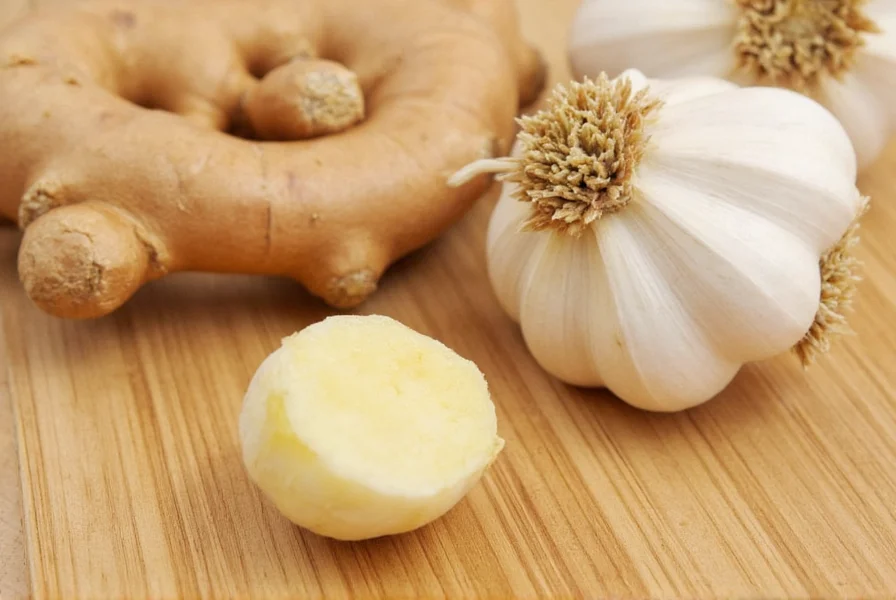Ginger (Zingiber officinale) and garlic (Allium sativum) have been staples in traditional medicine systems and global cuisines for thousands of years. These pungent ingredients not only enhance flavor profiles but also contain bioactive compounds that may contribute to various health benefits. Understanding their nutritional composition, culinary applications, and evidence-based health properties helps consumers make informed decisions about incorporating them into their diets.
Nutritional Profiles of Ginger and Garlic
Both ingredients offer unique nutritional compositions that contribute to their health-promoting properties. Ginger contains gingerols and shogaols as its primary bioactive compounds, while garlic's key component is allicin, formed when cloves are crushed or chopped.
| Nutrient | Ginger (100g) | Garlic (100g) |
|---|---|---|
| Calories | 80 kcal | 149 kcal |
| Carbohydrates | 17.8 g | 33.1 g |
| Fiber | 2 g | 2.1 g |
| Vitamin C | 5 mg (8% DV) | 31.2 mg (52% DV) |
| Manganese | 0.2 mg (10% DV) | 1.7 mg (73% DV) |
| Key Bioactives | Gingerols, Shogaols | Allicin, Ajoene |
Evidence-Based Health Benefits
Scientific research has investigated numerous potential health benefits of ginger n garlic, though the strength of evidence varies across claims. The most well-supported benefits include:
Digestive Health Support
Ginger has demonstrated effectiveness in reducing nausea and vomiting, particularly for pregnancy-related morning sickness and chemotherapy-induced nausea. A 2020 systematic review published in Nutrients found ginger supplementation significantly reduced nausea severity. Garlic also shows potential digestive benefits through its prebiotic properties that support gut microbiome diversity.
Anti-Inflammatory Properties
Both ingredients contain compounds with anti-inflammatory effects. Ginger's gingerols inhibit inflammatory pathways similar to non-steroidal anti-inflammatory drugs (NSAIDs), but without the same side effects. Research in the Journal of Medicinal Food indicates ginger supplementation may reduce markers of inflammation in people with osteoarthritis. Garlic's sulfur compounds also demonstrate anti-inflammatory activity that may benefit cardiovascular health.
Cardiovascular Support
Studies suggest garlic may help maintain healthy blood pressure levels and improve cholesterol profiles. A meta-analysis in Experimental and Therapeutic Medicine found aged garlic extract significantly reduced blood pressure in hypertensive individuals. Ginger shows potential for improving lipid profiles, though more research is needed to confirm these effects.
Culinary Applications of Ginger and Garlic
The combination of ginger n garlic creates foundational flavor bases across numerous global cuisines. Their complementary pungency and aromatic qualities make them versatile ingredients that enhance both savory and sweet dishes.

Asian Cuisine Foundations
In many Asian cooking traditions, ginger and garlic form the aromatic base for countless dishes. The "holy trinity" of Chinese cooking often includes ginger, garlic, and scallions, while Indian cuisine frequently uses ginger-garlic paste as a marinade base for meats and vegetables. The enzymatic reaction when these ingredients are crushed together creates complex flavor compounds that enhance overall dish profiles.
Optimal Preparation Techniques
How you prepare ginger and garlic significantly impacts their flavor and potential health benefits:
- Garlic: Crushing or chopping activates alliinase enzymes that convert alliin to allicin. For maximum allicin production, let chopped garlic rest for 10 minutes before cooking
- Ginger: Grating releases more gingerols than slicing. Fresh ginger provides different compounds than dried ginger powder
- Combination: When using both together, add garlic later in cooking as it burns more easily than ginger
Traditional Uses vs. Scientific Evidence
Many traditional claims about ginger n garlic benefits circulate online, but scientific evidence varies in strength. While some traditional uses align with research findings, others lack sufficient evidence.
Supported Traditional Uses
Research supports several traditional applications:
- Nausea reduction (particularly ginger for pregnancy and motion sickness)
- Temporary relief of osteoarthritis symptoms
- Moderate blood pressure support (garlic)
- Antimicrobial properties (both show activity against certain bacteria and fungi)
Claims Requiring More Research
Some popular claims need additional rigorous human studies:
- Cancer prevention (while laboratory studies show promise, human evidence is limited)
- "Detoxification" properties (the body has its own detoxification systems)
- Significant weight loss effects
- Cure for common cold (may reduce duration but not prevent)
Practical Usage Guidelines
Understanding how to select, store, and prepare ginger and garlic maximizes both flavor and potential health benefits.
Selection and Storage
- Ginger: Choose firm, smooth roots with tight skin. Store in refrigerator for up to 3 weeks or freeze for longer storage
- Garlic: Select firm, heavy bulbs with tight skin. Store in cool, dark place (not refrigerator) for optimal shelf life
- Prepared ginger-garlic paste can be stored in freezer for convenient use
Daily Consumption Recommendations
While both are generally safe as culinary ingredients, moderation is key:
- Ginger: Up to 4 grams daily appears safe for most adults (about 1-2 inches of fresh root)
- Garlic: 2-5 grams of fresh garlic daily (approximately 1-2 cloves)
- Higher therapeutic doses should be discussed with healthcare providers

Potential Considerations and Side Effects
Though generally safe as food ingredients, ginger n garlic may cause issues for some individuals:
- May interact with blood-thinning medications (consult doctor if taking anticoagulants)
- Can cause heartburn or digestive upset in sensitive individuals
- Garlic may cause bad breath and body odor
- Raw garlic applied to skin can cause irritation or burns
- Some people experience allergic reactions to either ingredient
Conclusion
Ginger and garlic represent remarkable examples of culinary ingredients with potential health-supporting properties. When incorporated as part of a balanced diet, they contribute both distinctive flavors and bioactive compounds that may support various aspects of health. While scientific research continues to explore their mechanisms and benefits, their longstanding use in global cuisines speaks to their versatility and value. Understanding the evidence behind health claims helps consumers make informed decisions about using ginger n garlic for both culinary enjoyment and potential wellness benefits.
Frequently Asked Questions
What are the most scientifically supported health benefits of ginger and garlic?
The most well-supported benefits include ginger's effectiveness for reducing nausea (particularly during pregnancy and chemotherapy) and both ingredients' anti-inflammatory properties. Garlic shows evidence for supporting cardiovascular health by potentially reducing blood pressure and improving cholesterol profiles. Both demonstrate antimicrobial properties, though these are more relevant for food safety than medical treatment.
Can ginger and garlic be taken together for enhanced benefits?
Yes, ginger and garlic can be safely consumed together and may offer complementary benefits. Their combined anti-inflammatory effects could potentially provide synergistic support for conditions like arthritis. Many traditional medicine systems use them together in formulations. However, if taking blood-thinning medications, consult your healthcare provider as both have mild anticoagulant properties.
How should I prepare ginger and garlic to maximize their health benefits?
For garlic, crush or chop cloves and let them rest for 10 minutes before cooking to maximize allicin production. Add garlic later in the cooking process as high heat degrades beneficial compounds. For ginger, grating releases more active compounds than slicing. When using both together, add garlic after ginger since it burns more easily. Raw consumption preserves the most compounds, but both remain beneficial when cooked appropriately.
Are there any risks associated with consuming large amounts of ginger and garlic?
Excessive consumption (more than 4 grams of ginger or 5 grams of garlic daily) may cause digestive upset, heartburn, or interact with certain medications. Both have mild blood-thinning effects, so those taking anticoagulants should consult their doctor. Raw garlic applied to skin can cause burns, and some people experience allergic reactions. As with any food, moderation is key when incorporating ginger n garlic into your diet.
How do ginger and garlic complement each other in cooking?
Ginger and garlic create a powerful flavor foundation in many global cuisines. Ginger provides bright, citrusy warmth while garlic offers savory depth. When cooked together, their compounds interact to create complex flavor profiles that enhance meats, vegetables, and sauces. In Asian cooking, they often form the aromatic base along with scallions. The enzymatic reaction when both are crushed creates additional flavor compounds that neither produces alone, making them particularly effective when used in combination rather than separately.











 浙公网安备
33010002000092号
浙公网安备
33010002000092号 浙B2-20120091-4
浙B2-20120091-4